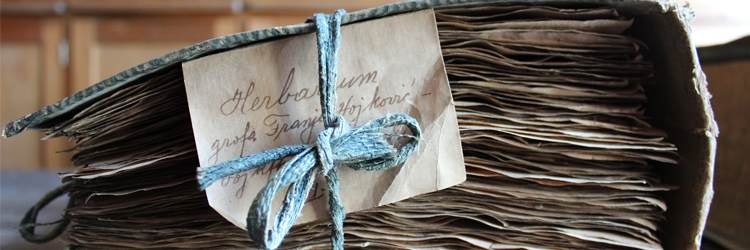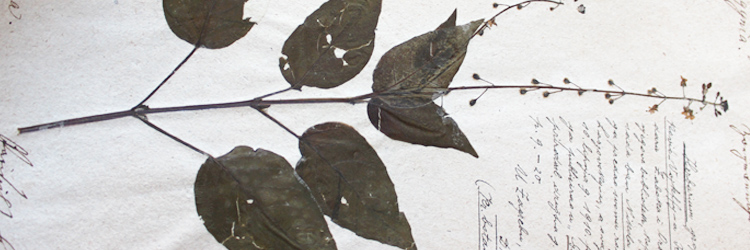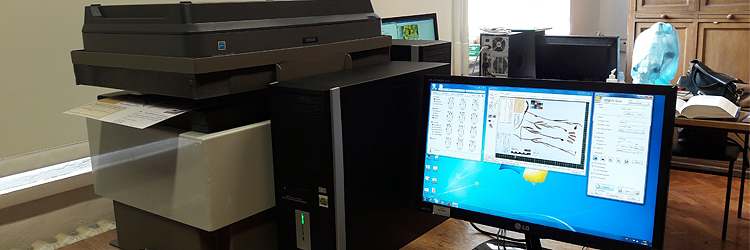History
Within the Division of Botany of the Department of Biology, Faculty of Science at the University of Zagreb there are two officially registered (listed in Index Herbariorum) University herbarium collections: Herbarium Croaticum (ZA), and Ivo and Marija Horvat herbarium (ZAHO). These are the two oldest and largest collections in Croatia. The first collection contains herbarium specimens collected by various researchers during the past 200 years, while the second collection is the fruit of lifetime labour of professor Ivo Horvat and his wife Marija.
Herbarium Croaticum (ZA) collection was founded in 1880 (although the oldest specimens date back to 1820), and it is the oldest and largest herbarium in the Republic of Croatia. Historically, this collection represents continuous botanical activity since the times of Illyrian revival when, even before the founding of the National museum in Zagreb in 1846, a substantial quantity of botanical material was already collected, based on the herbarium od Josip Host. After the founding of the National museum, this botanical collection was supplemented by the herbarium of Hugo von Klinggräff, later to be expanded by collections of numerous researchers, most noteworthy being Josip Schlosser, Ljudevit Vukotinović, Mato Vodopić, Franz Petter, Antun Pavić, Slavoljub Wormastiný, Augustin Grubišić, Matija Botteri, Ana Maria Smith, Elise Braig, Maria de Cattani, and Josip Pančić.
Upon the founding of the University and the appointment of Bohuslav Jiruš as the first professor of botany in 1875, Spiridion Brusina initiated a transfer of the ownership of the National museum’s herbarium collection to the Department of Botany and Physiology - present day Division of Botany at the Faculty of Science, which was approved by the Government. At first, the Division of Botany and Physiology and the collection were housed in two rooms on the second floor of Gornjogradska Gymnasium. In 1882 they relocated to the present-day Senate building. Following that, in 1920 the collection was moved to the building at 20 Marko Marulić Square, where it remains to present day.
From then on the collection grows steadily, thanks to the contribution of generations of national, and a few international, researchers, most notably Vale Vouk, Ivo Horvat (material not included in personal collection; ZAHO), Stjepan Horvatić, Karlo Bošnjak, Ivan Soklić, Josip Linardić, Ante Ercegović, Fran Kušan, Stjepan Urban, Zora Klas, Ivo Pevalek, Zlatko Pavletić, Bogdan Korica, Radovan Domac, Ljerka Marković, Ljudevit Ilijanić, Marija Bedalov, Nedeljka Šegulja, Ivan Šugar, and Miško Plazibat.
The Herbarium of Ivo and Marija Horvat (ZAHO) was established in 1918 and has approximately 78,000 specimens, mainly of vascular plants collected in Croatia, but also from other Balkan and European countries. The collection was at first located at the Faculty of Veterinary Medicine where prof. Horvat worked from 1943 to 1963. Eventually it was moved to the premises of the former Yugoslav, today Croatian Academy of Sciences and Arts and finally in 1998 it was relocated to 9a Marko Marulić Square, where it is still today.
The collections today
The ZA collection is located on 20a Marko Marulić Square, in the south wing section on the 2nd floor. It counts over 200,000 herbarium specimens and consists of three main separate units:
• herbarium of world flora (Herbarium Generale),
• herbarium of Croatian flora (Herbarium Croaticum sensu stricto), and
• cryptogamic herbarium (Herbarium Cryptogamicum, algae, mushrooms, lichens and mosses).
The collection continues to be complemented by new specimens collected by the staff of the Division of Botany, as well as by donations of plant material from many Croatian and foreign botanists.
Herbarium Ivo and Marija Horvat (ZAHO) is located on 9a Marko Marulić Square, within the Botanical Gardens. This collection consists of herbarium of vascular flora and cryptogamic herbarium. All specimens within this collection were collected by Ivo Horvat and this collection is no longer being complemented by additional specimens.
Activities
The Herbaria of the Department of Biology, Faculty of Science (ZA and ZAHO) are a source of information for national and international botanical community. Storing specimens permanently and making them accessible to botanists, primary users, and to others, under the general regulations on property rights, are the main objectives of curation. The main activities include:
• Systematization and digitization of herbarium specimens,
• Collection of new specimens,
• Maintaining the collection by mounting herbarium specimens and performing pest control.
Herbarium collections ZA and ZAHO and their Virtual herbarium, with all so far databased and digitized herbarium specimens accessible to public, are available at http://herbariumcroaticum.biol.pmf.hr
Importance of collections
Natural science collections represent an invaluable source of information for a variety of biological researches. The collection of dried plant specimens with appropriate accompanying data and internal organization is called herbarium. Herbaria are primarily used by researchers dealing with systematic botany, taxonomy and flora of a certain area, and provide insight into the variety of plant taxa, biodiversity of a given area, distribution of diversity, population trends in space and time, while exceptionally preserved specimens can also be used for molecular and phylogenetic research. In addition to the scientific role, herbaria play an important role in botany and flora education, as the students are presented with and educated about richness and diversity of the plant world.
Once a year, during the "Night of Biology" event organized by the Department of Biology, the collection is open to public. The collection staff are also regularly involved in a variety of workshops open to public within different manifestations, such as "The Week of Botanical Gardens and Arboretums".
Curators: Ivana Rešetnik, PhD
Vedran Šegota, BSc
 Pristupačnost
Pristupačnost

